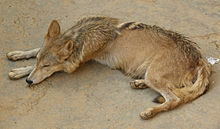Indian wolf
| Indian wolf | ||||||||||||
|---|---|---|---|---|---|---|---|---|---|---|---|---|

Indian wolf ( Canis lupus pallipes ) |
||||||||||||
| Systematics | ||||||||||||
|
||||||||||||
| Scientific name | ||||||||||||
| Canis lupus pallipes | ||||||||||||
| Sykes , 1831 |
The Indian wolf ( Canis lupus pallipes ) is a subspecies of the wolf . Recent genetic studies indicate, however, that the Indian wolf, like the Tibetan wolf, may not be a subspecies of the wolf, but a species in its own right.
features
The Indian wolf is somewhat gaunt compared to wolves living in the north and is one of the smallest subspecies. Its body length is usually around 90 cm, the shoulder height averages 66 cm. The rod length is approx. 44 cm. The weight is between 15 and 20 kg. Its fur is typically yellow-brown, sand-colored or reddish in color and very short and dense.
Occurrence
The Indian wolf inhabits the plains of Western India from Bengal and Sindh to Karnataka in the south and Western Asia from Pakistan to Mesopotamia and northern Arabia in the west.
In India it inhabits arid areas such as the semi-deserts of Gujarat with only 300 mm annual precipitation as well as areas with around 1500 mm annual precipitation in Bihar and Orissa .
Hazard and protection
The Indian wolf has become rare today and is considered critically endangered. Its decline is mainly attributed to the disappearance of its natural prey. It has been under protection in India since 1972.
In India, wolves are still found in isolated areas in the states of Andhra Pradesh , Karnataka , Maharashtra , Madhya Pradesh , Gujarat , Rajasthan , Orissa , Bihar , West Bengal , Uttar Pradesh and Haryana . Different estimates from the 1980s and 1990s assume 500 to 3000 wolves on the entire Indian Peninsula, whereby the lower estimates are probably too low. Most wolves in India live in arid areas outside of sanctuaries and feed primarily on domestic animals. In areas where natural prey such as stag goat antelopes are still common, such as in Blackbuck National Park , they prefer natural prey.
Wolf and human
Due to the fact that the Indian wolf hunts humans' pets, confrontations often occur. There are repeated attacks by wolves on people, mostly children and old people. Between April 1993 and April 1995, 80 children were attacked by five different packs of wolves, with only 20 children saved. The children were primarily attacked in the vicinity of the settlement in the summer. Because of its food, the wolf has developed an aggressive feeding behavior towards humans.
literature
- Claus Hilschmann: Fauna Volume 7 The Oriental Region , Novaria-Verlag, 1971. ISBN 2-8270-0869-6
Individual evidence
- ↑ RK Aggarwal 1, T. Kivisild 2, J. Ramadevi 1 and L. Singh: Mitochondrial DNA coding region sequences support the phylogenetic distinction of two Indian wolf species . Journal of Zoological Systematics and Evolutionary Research Volume 45 Issue 2, Pages 163 - 172 (2007)
- ↑ a b Indian Wolf on Mythos-Wolf, accessed on May 23, 2020.
- ^ Shahi, SP: Status of the gray wolf (Canis lupus pallipes Sykes) in India: A preliminary survey. Journal of the Bombay Natural History Society. Bombay [J. BOMBAY NAT. HIST. SOC.]. Vol. 79, no. 3, pp. 493-502. 1982.
- ↑ M. Singh & HN Kumara: Distribution, status and conservation of Indian gray wolf ( Canis lupus pallipes ) in Karnataka, India . Journal of Zoology, Volume 270, Issue 1, pages 164-169, September 2006 online link
